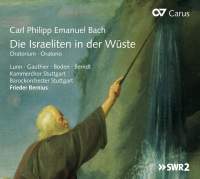Texte paru dans: / Appeared in: |
|
|
Outil de traduction (Très approximatif) |
|
|
|
|
|
Reviewer: Lynn
René Bayley In his extended sacred choral-orchestral works, C. P. E. Bach’s music was much closer in style to that of his father than in any of his other works, and this 1769 oratorio is no exception. That being said, The Israelites in the Wilderness is an excellent work, easily the equal in musical and dramatic quality to his father’s St. John Passion, and in certain places—particularly the arias—you hear a different musical voice, one more dramatic, more modern in his use of the orchestra (swirling and stabbing strings, for instance) that did not occur to Johann Sebastian. Small wonder, then, that although it was written for a celebratory event (the consecration of the Lazarett-Kirche or hospital church in Hamburg, the notes tell us), it made such an impact that Bach’s friend Friedrich Klopstock persuaded him to publish it. Bach agreed and had it done, but his publisher (Breitkopf) refused to promote it; the composer was expected to distribute and sell the 360 copies himself. Fortunately, this was one work that had a certain vogue at the time and so the run was eventually sold out. (The notes indicate that Bach rather liked this system, since he and Klopstock knew where and how to market his complex classical works.) Although the Stuttgart Baroque Orchestra clings tenaciously to the religion of straight tone, I am pleased to report that, like Tafelmusik, the ensemble members believe in proper phrasing and the use of dynamics, which makes the performance come alive despite this historically incorrect flaw. I am also happy to report that they do not duplicate the puny forces that Bach had to use in Hamburg, which were 20 musicians and seven singers in the chorus (originally eight, but one of them was ill at the time of the premiere). This is a relief, although they seem to have based their decision on the fact that Charles Burney complained that the debut performance was “too sparsely staffed.” I suppose that if Burney had liked it, we’d be stuck with seven singers and 20 players! There is a wonderful orchestral-choral passage of great drama (the chorus of Israelites, “Du bist der Ursprung unsrer Not”), and the middle portion of the Israelites’ duet is certainly of a musical character that would not have occurred to the mathematically-balanced mind of Bach Sr. (J. S.). Another feature of this work that makes it different from his father’s is Carl Philipp’s propensity to use many more solo than choral sections. J. S.’s mathematical mind would surely have found a way to insert more choral passages to balance out the solo vocals. The singers are uniformly excellent, particularly soprano Lunn (First Israelite) whose voice is not only crystal-clear but also fairly powerful, with a gorgeous “ring” up top. Tenor Boden has a lovely voice and excellent fluidity, including a fine trill, and Gauthier as the Second Israelite has an interesting tone but a more typically Germanic sound in her upper register (although she, too, shows fine flexibility in her turns and grace notes). My lone complaint, and it is a small one, is that the baritone voice used for Moses is too light; a darker-voiced baritone or a basso cantate would have been ideal, but Berndt certainly has a pleasant voice and does his best. I also liked the general sound of the chamber chorus, not too over-refined to the point where their voices sound more like a computer than human beings. I personally liked this performance better than the famous recording by William Christie (with Barbara Schlick, Lena Lootens, Hein Meens, and Stephen Varcoe as soloists) because of its more dramatic accents and tauter performance style (the Bernius recording times out at about four minutes shorter than Christie), but you won’t really go wrong with either version, and the sonics on this one are absolutely spectacular (in addition to the fact that I liked Lunn’s voice much more than Schlick’s). You can almost hear the sounds of the instruments as if they were in your living room, and odd as it sounds, the orchestra and chorus almost breathe together. Enthusiastically recommended. | |
|
|
|
|
Cliquez l'un ou l'autre
bouton pour découvrir bien d'autres critiques de CD |
|




